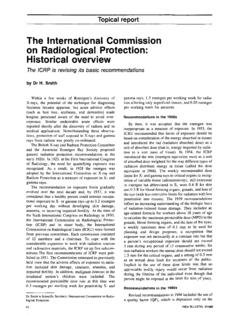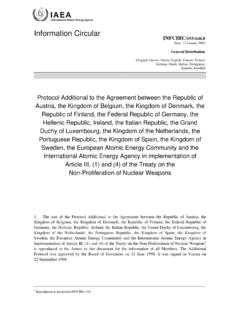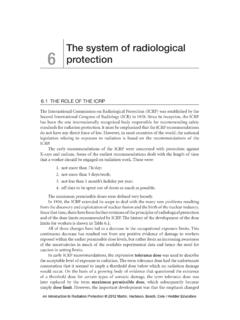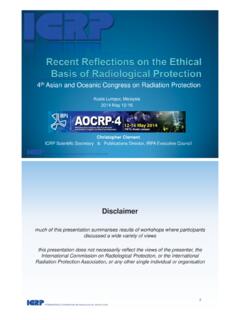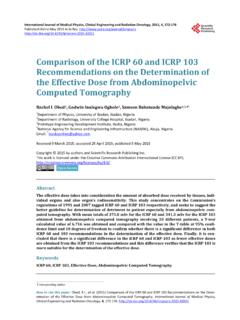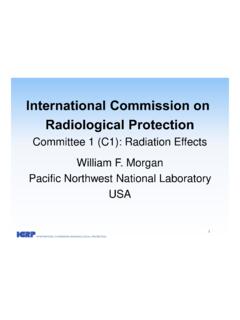Transcription of RADIOLOGICAL PROTECTION - International Atomic Energy …
1 21 IAEA BULLETIN, 42/3/2000 Just over a decade ago, theInternationalCommission onRadiological PROTECTION (ICRP) elaborated, inPublication 60,a radiologicalprotection policy whoseprimary aim is to provide anappropriate standard ofprotection for people withoutunduly limiting the beneficialpractices giving rise toradiation exposure. Beneficial practices may giverise to radioactive waste; theCommission s policy for thedisposal of all types ofradioactive waste is given inPublication 77, RadiologicalProtection Policy for the Disposalof Radioactive Waste. In thecontext of the commission srecommendations, waste is anymaterial that will be or hasbeen discarded as being of nofurther use. Wasteincludesliquid and gaseous effluents aswell as solid materials such asprocess residues. Waste storageis the temporary retention ofwaste. Waste disposalis thediscarding of waste with nointention of retrieval.
2 Theterm disposal covers thedischarge of effluents and solidwaste disposal. Wastemanagement means the wholesequence of operations startingwith the generation of wasteand ending with disposal strategies canbe divided into two conceptualapproaches: dilute anddisperse or concentrate andretain . Early or deferredreleases of radionuclides to theenvironment would inevitablyresult from either of thesestrategies and therefore anobjective of no release in notfeasible. Both strategies are incommon use and are notmutually exclusive. Thepossibility of elevatedexposures from disruptiveevents is an inescapableconsequence of the decision toconcentrate waste in a disposalfacility rather than diluting ordispersing commission s system ofprotection is directly applicableto the dilute and disperse strategy. Exposures areestimated in order to placeadequate control on the sourceof exposure.
3 Thecharacteristics and habits ofexposed individuals andpopulations are taken intoaccount. Furthermore, in thesesituations it can be verified to agreat extent that PROTECTION isbeing achieved by measuringreleases to the environmentand by taking action in thecase of unexpected the case of disposal oflong-lived solid radioactivewaste using the concentrateand retain strategy, the mainprotection issue concernsexposure that may or may notoccur in the far future, , asituation of potential effective waste disposalsystem will retain the wastesduring the period of greatesthazard with only residualradionuclides entering theenvironment in the far corresponding estimates ofdoses to individuals andpopulations will have growingassociated uncertainties as afunction of time due toincomplete knowledge of thefuture disposal systembehaviour, of geologic andbiosphere conditions and ofhuman habits andcharacteristics.
4 Nevertheless,the commission s system ofprotection can be applied tothe disposal of long-livedradioactive 81, RadiationProtection Recommendations asApplied to the Disposal of Long-lived Solid Radioactive Waste,deals with the RADIOLOGICAL pro-tection of members of the pub-lic following the disposal oflong-lived solid radioactivewaste using the concentrateand retain strategy. It coversoptions including shallow landburial and deep geological dis- RADIOLOGICAL PROTECTIONRECOMMENDATIONS ON RADIOACTIVE WASTE MANAGEMENT FROMTHE International commission ON RADIOLOGICAL PROTECTIONBY ROGER H. CLARKER oger Clarke is Chairman of the International commission onRadiological PROTECTION and is Director of the United KingdomRadiological PROTECTION Board. He also is the UK Representative at theUnited Nations Committee on the Scientific Effects of AtomicRadiation (UNSCEAR) and visiting Professor at Imperial College,University of London and at the University of BULLETIN, 42/3/2000posal.
5 The recommendationsapply to new disposal facilitieswhere there is the opportunityfor their implementation dur-ing the site selection, design,construction and operationalphases; they should also betaken into account in justifica-tion decisions involving prac-tices generating waste. TheCommission is also issuing inPublication 82, Principles forthe PROTECTION of the Public inSituations of ProlongedExposure,recommendations fordealing with long livedradioactive residues already inthe environment arising from,for example, past practices thatwere not RADIOLOGICAL assessment ofa disposal system for solidradioactive waste needs to con-sider the various possibilitiesfor human exposure. Processes,which could lead to humanexposures, have to be identifiedon a site-specific basis. Somenatural processes may result ina gradual release of radionu-clides to the environment. Atypical example is the gradualdegradation of the waste pack-age due to corrosion and theconsequent release of radionu-clides.
6 Subsequent naturalprocesses, which could lead tohuman exposure, may includetransport of radionuclides bygroundwater with the associ-ated processes of sorption, dif-fusion and dispersion. Other,less likely, natural processesmay disrupt or otherwise affectthe performance of the disposalsystem, , seismic events actions in the futuremay also disrupt a waste dis-posal system. A human actionaffecting repository integrityand potentially having radio-logical consequences is knownas human intrusion. The con-sequences for a deliberateintruder are primarily consid-ered the intruder s responsibil-ity. There is also the possibilityof inadvertent human intru-sion after knowledge of the dis-posal system has been lost, ,actions taken unknowingly bysomeone that disrupt the wastedisposal system. These actionsinclude inadvertent drillinginto a deep repository andinadvertent construction on ashallow repository.
7 Such inad-vertent actions are the mainissue for human intrusion inthe long term; here, the termhuman intrusion refers to inad-vertent dosimetric quantitiesused by the commission aredefined inPublication 60. (Inthis article the term dosemeans effective dose.) Thequantity that reflects both thedose and the number ofpeople is the collective dose,given by the product of themean dose to an exposedgroup and the number ofindividuals in the , in paragraph 58 ofPublication 77, theCommission recognized theproblems of estimatingcollective dose over longperiods into the future. Boththe individual doses and the sizeof the exposed populationbecome increasingly uncertain astime increases. Furthermore, thecurrent judgements about therelationship between dose anddetriment may not be valid forfuture populations .. forecastsof collective dose over periodslonger than several thousandyears and forecasts of healthdetriment over periods longerthan several hundred yearsshould be examined critically.
8 Justificationof a and disposaloperations are an integral partof the practice generating thewaste. It is wrong to regardthem as an independentpractice, needing its ownjustification. The wastemanagement and disposaloperations should therefore beincluded in the assessment ofthe justification of the practicegenerating the waste. If thenational waste disposal policyhas changed and the practice iscontinuing, it may be necessaryto reassess the justification ofthe practice. If the practice hasceased, it is intervention ratherthan the practice that has to beconsidered for main inputto optimization of protectionhas generally been taken tomean the total (integrated) col-lective effective dose. Howeverfor solid waste disposal, the useof collective dose is far fromideal. The optimization of pro-tection has become too closelyassociated with collective doseand the use of cost-benefitanalysis and other quantitativeprocedures.
9 Misunderstandingsin the use of collective dose,unrestricted in space and time,lead to the misapplication ofresources. At long distancesand periods, the estimates ofindividual and collective dosesare unreliable, partly because ofuncertainties in modellingtechniques. For effluent assess-ments, collective doses shouldbe used with great caution andpresented to decision-makersin disaggregated blocks of indi-vidual doses and the time whenthey will be optimization of protec-tion has the broad interpreta-23 IAEA BULLETIN, 42/3/2000tion of doing all that is reason-able to reduce doses. Much ofthe commission s emphasis isnow on the qualitative specifica-tion of the optimization of pro-tection. The basic role of theconcept of optimization of pro-tection is to engender a state ofthinking in everyone responsi-ble for control of radiationexposures such that they arecontinually asking themselvesthe question: Have I done allthat I reasonably can to reducethese radiation doses?
10 Thus,the commission s policy onoptimization is judgmental andin essence is summarized inparagraph 117 ofPublication 60-- If the next step of reducingdetriment can be achieved onlywith a deployment of resourcesthat is seriously out of line withthe consequent reduction, it isnot in society s interests to takethat of FutureGenerations. The objective ofprotecting future generationsto at least the same level as cur-rent generations implies theuse as indicators of the currentquantitative dose and risk con-straints derived from consider-ing the associated health detri-ment. Publication 77statesthat doses and risks, as mea-sures of health detriment, can-not be forecast with any cer-tainty for periods beyondaround a few hundreds ofyears into the future. Instead,estimates of doses or risks forlonger time periods can bemade and compared withappropriate criteria in a test togive an indication of whetherthe repository is acceptablegiven current understanding ofthe disposal system.
